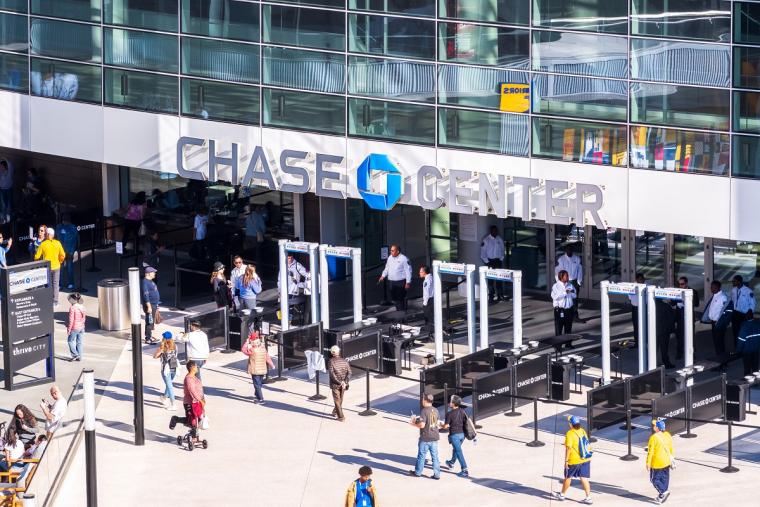
For many sports fans attending live events, one question continues to go unanswered: Will I be safe? Regardless of the size of the sporting event, whether a high school playoff game or an NCAA tournament, evaluating and preparing safety procedures for all events is a critical issue.
Unfortunately, horrific instances of mass violence are all too familiar today. Whether they occur on school campuses, in public spaces or at large sporting events, it is vital that venue security teams take advantage of every available tool to keep attendees safe. The most prominent examples of mass violence at sporting events —such as terrorist attacks at the Olympics or the 2013 Boston Marathon bombing—recall moments when security measures failed to protect athletes and fans alike. However, on a smaller scale, just one month after schools reopened in 2021, over 20 incidents involving guns at youth sporting events were recorded, according to Everytown for Gun Safety.
Between August 20 and September 25, Everytown tracked 22 incidents involving guns at football games and soccer matches, from Little League to college, in 14 states. Some turned deadly, including a college football game in Durham, North Carolina, where police said two people were fatally shot. For fans to feel confident attending sporting events, small and large, implementing proactive and effective safety measures is imperative.
What "Safety” Means at Sports Events
Feeling safe enough to attend a large event venue, however, doesn’t just concern fear related to gun violence. Fights, feuding parents and rowdy spectators have become the norm. In addition, “The risk of sexual violence increases greatly at sports events”, said Rothna Begum, a women’s rights researcher at Human Rights Watch. Heart attacks and other stress-related health issues are also becoming increasingly common at sports events, according to The Athletic. Far beyond the statistically rare occurrences of bombings and gun violence, implementing security measures to keep fans “safe” must follow a holistic approach.
Looking forward, it will be up to security professionals, public safety consultants and event sponsors to advocate for embracing new technology to improve safety, security and real-time response at sports events.
The Shortcomings of Traditional Security Technology
Even though security technology has advanced significantly over the last decade, many venues still suffer from fundamental problems related to limited security staff and uncoordinated crisis response. For example, sports event venues deploying surveillance cameras as a stand-alone solution still find themselves unprepared to address prolific issues, such as missing persons, theft, medical emergencies, sexual assaults and violence. Regardless of the number of cameras a venue may deploy, without the ability to verify reports, communicate with attendees and disseminate mass alerts—security staff will remain underequipped.
In order to address ongoing emergencies in real-time, it is critical that sports event venues integrate crowdsourced intelligence software to enable real-time engagement with patrons. Using customizable geofencing technology, these solutions give anybody that downloads the app the ability to communicate directly with onsite security personnel, increasing a security team’s footprint and acting as a force multiplier for first responders.
 The Future of Crowdsourced Intelligence
The Future of Crowdsourced Intelligence
The statistic behind this solution is simple: By the end of 2022, the number of mobile phone users around the world was 7.26 billion, meaning at least 90.72% of the globe owned a cell phone. In the U.S., that number was even higher. According to Pew Research, 97% of Americans own a cellphone. Conservatively, this means at least nine out of ten fans have the tools they need to report incidents to onsite safety and security personnel—all they need to do so is a cloud-based platform to facilitate that communication.
From the perspective of security infrastructure, this statistic offers more good news for stadiums, schools and other event venues: Crowdsourced intelligence apps are easy to integrate into existing security procedures. Not only is the software effortless to learn, integrating real-time, two-way communication capabilities between security personnel and fans also acts as a force multiplier for onsite staff, without requiring additional personnel. Considering how easy it is for attendees to download a free app, putting safety in every hand is an infrastructural no-brainer.
On top of this, using agnostic, customizable geofencing technology enables event security to extend its perimeter into surrounding parking lots and communities, protecting patrons well before they arrive, offering community members and fans peace of mind.
Safety in Every Hand
The best part is that implementing crowdsourced intelligence is as easy as it sounds. It also takes the guesswork out of keeping fans safe, putting power in the hands of the people who need it most, equipping security personnel with the one thing they often lack: resources. As crowd sizes at sports events continue to grow, we need to give event security the tools they need to keep everyone safe.

